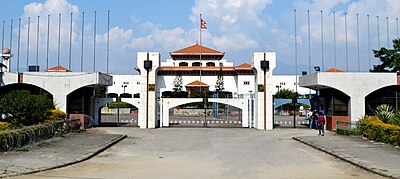Pratinidhi Sabha
The Pratinidhi Sabha ( Nepali प्रतिनिधि सभा , German: House of Representatives ) is the lower house of the Parliament of Nepal , the Sanghiya Sansad .
history
The House of Representatives, which was elected in 1999, was dissolved in May 2002 due to early parliamentary elections. After Maoist rebels threatened to disrupt the elections, Prime Minister Sher Bahadur Deuba asked the king to postpone the elections for a year. The king then dismissed the government and postponed the elections indefinitely. In February 2005, King Gyanendra took direct power over the kingdom, accusing the government of failing to make arrangements for parliamentary elections. The parliament could not meet because the constitution of the time stipulated that the national assembly , the upper house, could not be convened without the house of representatives. In April 2006, King Gyanendra agreed to convene the House of Representatives after a wave of street protests calling for new elections.
After numerous postponements, the House of Representatives passed a transitional constitution in January 2007. The House of Representatives then dissolved in favor of a 330-member constituent assembly. This assembly, which was elected in April 2008 , assumed the function of a transitional parliament . Despite repeated extensions of its two-year term of office, the first constituent assembly was unable to agree on a new constitution as part of the transformation of Nepal from a kingdom to a republic. The elections for the second constituent assembly took place in November 2013, and the new constitution was adopted in 2015 . In accordance with the transitional provisions, the Constituent Assembly took on the role of the regular parliament on September 20, 2015 until new elections. These took place on November 26, 2017 and December 7, 2017.
Electoral system
A total of 275 members sit in the House of Representatives, of which 165 are elected by majority vote and 110 others are elected by proportional representation. The parties that run proportional representation candidates have an obligation to ensure representation of women and a range of social, ethnic and religious groups. Women should make up at least a third of the total number of elected members of each party in the federal parliament. In the event that a party fails to reach this number by majority vote, it will need to run more women on proportional representation to ensure that a third of its total elected candidates are women.
For the majority election, the country is divided into 165 constituencies. This classification should take into account not only geographical but also ethnic aspects.
The legislative period is five years.
elections
- 2017 : The electoral alliance between the Communist Party of Nepal (Marxist-Leninists) (CPN-UML) and the Communist Party of Nepal (Maoists) (CPN-MC) won the election and achieved almost a two-thirds majority with a total of 174 seats. The new Prime Minister was Khadga Prasad Oli from the CPN-UML.
Web links
Remarks
- ^ Parliament House View. Retrieved September 20, 2018 .
- ↑ a b Nepal. Pratinidhi Sabha (House of Representatives). Last Elections. Inter-Parliamentary Union, accessed September 16, 2018 .
- ↑ Nepal. Pratinidhi Sabha (House of Representatives). Electoral system. Inter-Parliamentary Union, accessed September 16, 2018 .
- ^ Constitution of Nepal, Article 84 (1) a . 2015 ( deutsch-nepal.de [PDF] Unofficial English Translation).
- ↑ Nepal. Pratinidhi Sabha (House of Representatives). General Information About the Parliamentary Chamber. Inter-Parliamentary Union, accessed September 16, 2018 .

